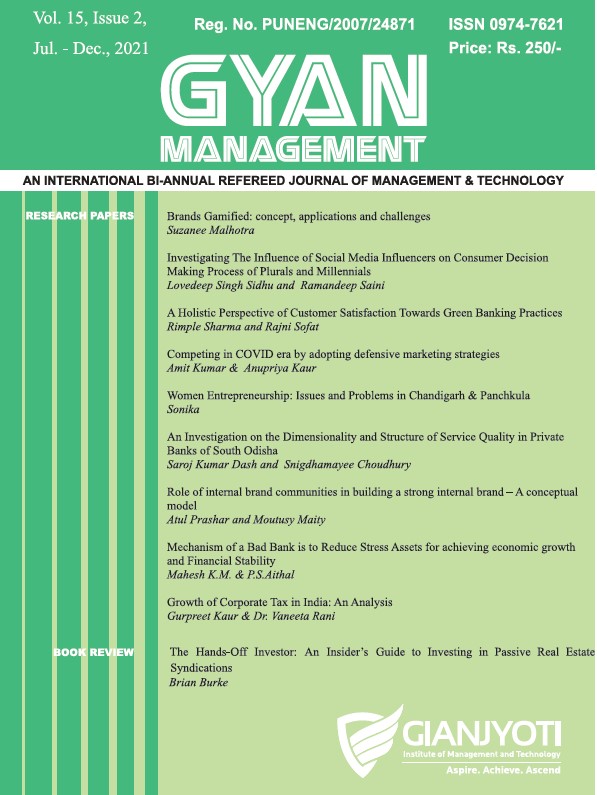Perception of Anthropomorphism, Intelligence and Adoption of AI: A case in mobile banking
DOI:
https://doi.org/10.48165/gmj.2023.conf13Keywords:
Artificial intelligence (AI), Perceived Anthropomorphism (PA), Perceived Intelligence (PI), Adoption intentionAbstract
Purpose – Artificial intelligence (AI) has completely transformed the mobile banking industry, but little is known about how particular AI features influence consumer acceptance strategies and avoidance behaviours in the literature. To address this gap, the present study examines how users’ intentions to embrace AI-based mobile banking are influenced by the pivotal characteristics of AI, perceived intelligence and anthropomorphism. Design/methodology – A cross-sectional descriptive research design was used for this study. Further, a judgemental non-probability sam pling was employed to identify the 100 respondents. The data was sub sequently analysed using PLS-Structural Equation Modeling. Findings – The results exhibit that both PI and PA positively and sig nificantly impacted consumers’ intention to adopt of AI-based mobile banking apps. It also offers theoretical underpinnings for the adoption of AI-based mobile banking apps. Furthermore, findings furnish prac tical guidance that can be instrumental for banks contemplating the implementation of AI to enhance user retention strategies. Originality/value –This study adds valuable contribution to the field by shedding light on the nuanced aspects of AI and their substantial impact on users’ intention to adopt mobile banking app services.
Downloads
References
Bartneck, C., Van Der Hoek, M., Mubin, O., & Al Mahmud, A. (2007, March). “Daisy, daisy, give me your answer do!” switching off a robot. In Proceedings of the ACM/IEEE international conference on Human
robot interaction (pp. 217-222).
Bartneck C, Kulić D, Croft E, Zoghbi S. Measurement instruments for the anthropomorphism, animacy, likeability, perceived intelligence, and perceived safety of robots. International journal of social robot
ics. 2009;1(1):71-81
Cho, W.-C., Lee, K.Y. and Yang, S.-B. (2019), “What makes you feel attached to smartwatches? The stim ulus–organism–response (S–O–R) perspectives”, Information Technology and People, Vol. 32 No. 2, pp. 319-343.
Davis, F.D. A Technology Acceptance Model for Empirically Testing New End-User Information Systems: Theory and Results. Ph.D. Thesis, Massachusetts Institute of Technology, Cambridge, MA, USA, 1986.
Epley N, Waytz A, Cacioppo JT. On seeing human: a three-factor theory of anthropomorphism. Psychological review. 2007; 114(4):864.
Grewal, D., Guha, A., Satornino, C.B. and Schweiger, E.B. (2021), “Artificial intelligence: the light and the dark ness”, Journal of Business Research, Vol. 136, pp. 229-236.
Gursoy D, Chi OH, Lu L, Nunkoo R. Consumers accep tance of artificially intelligent (AI) device use in ser vice delivery. International Journal of Information Management. 2019;49:157–69. doi:10.1016/j.ijinfo mgt.2019.03.008.
Hair, J.F., Hult, G.T.M., Ringle, C. and Sarstedt, M. (2013), A Primer on Partial Least Squares Structural Equation Modeling (PLS-SEM), SAGE Publications, Thousand Oaks, CA.
Henseler, J., Hubona, G. and Ray, P.A. (2016), “Using PLS path modeling in new technology research: updated guidelines”, Industrial Management and Data Systems, Vol. 116 No. 1, pp. 2-20.
Huang, M.H. and Rust, R.T. (2020), “A strategic frame work for artificial intelligence in marketing”, Journal of the Academy of Marketing Science, Vol. 49 No. 1, pp. 30-50.
Johnson, R. D., Marakas, G. M., & Palmer, J. W. (2008). Beliefs about the social roles and capabilities of com puting technology: Development of the computing technology continuum of perspective. Behaviour & Information Technology, 27(2), 169–181.
Lee, J. C., & Chen, X. (2022). Exploring users’ adop tion intentions in the evolution of artificial intelli gence mobile banking applications: the intelligent and anthropomorphic perspectives. International Journal of Bank Marketing, Vol. 40 No. 4, pp. 631- 658.
Lee, J. C., & Chen, C. Y. (2022). Motivating members’ involvement to effectually conduct collabora tive software process tailoring. Empirical Software Engineering, 27(7), 183.
Lee, J.C., Hsu, W.C. and Chen, C.Y. (2018), “Impact of absorptive capability on software process improvement and firm performance”, Information Technology and Management, Vol. 19, pp. 21-35.
Lin, R. R., & Lee, J. C. (2023). The supports provided by artificial intelligence to continuous usage intention of mobile banking: Evidence from China. Aslib Journal of Information Management.
Lu, L., Cai, R., & Gursoy, D. (2019). Developing and validating a service robot integration willing ness scale. International Journal of Hospitality Management, 80, 36-51.
Moussawi, S. and Koufaris, M. (2019), “Perceived intel ligence and perceived anthropomorphism of per sonal intelligent agents: scale development and validation”, Proceedings of the 52nd HI International
Conference on System Sciences, University of HI, HI, pp. 115-124.
Moussawi, S., Koufaris, M. and Benbunan-Fich, R. (2020), “How perceptions of intelligence and anthropomor phism affect adoption of personal intelligent agents”, Electronic Markets, Vol. 30 No. 1, pp. 1-10.
Pelau, C., Dabija, D.C. and Ene, I. (2021), “What makes an AI device human-like? The role of interaction qual ity, empathy and perceived psychological anthropo morphic characteristics in the acceptance of artificial intelligence in the service industry”, Computers in Human Behavior, Vol. 122, 106855.
Payne, E. M., Peltier, J. W., & Barger, V. A. (2018). Mobile banking and AI-enabled mobile banking: The dif ferential effects of technological and non-tech nological factors on digital natives’ perceptions and behavior. Journal of Research in Interactive Marketing, 12(3), 328-346.
Priya, R., Gandhi, A.V. and Shaikh, A. (2018), “Mobile banking adoption in an emerging economy: an empirical analysis of young Indian consumers”, Benchmarking: An International Journal, Vol. 25 No. 2, pp. 743-762.
Russell SJ, Norvig P (2016) Artificial intelligence: a modern approach. Pearson Education Limited, London Schiffman, L., O’Cass, A., Paladino, A., & Carlson, J.
(2013). Consumer behaviour. Pearson Higher Education AU.
Shankar, A., & Datta, B. (2018). Factors affecting mobile payment adoption intention: An Indian perspec tive. Global Business Review, 19(3_suppl), S72-S89.
Troshani, I., Rao Hill, S., Sherman, C., & Arthur, D. (2021). Do we trust in AI? Role of anthropomorphism and intelligence. Journal of Computer Information Systems, 61(5), 481-491.
Waytz, A., Cacioppo, J., & Epley, N. (2010). Who sees human? The stability and importance of individual differences in anthropomorphism. Perspectives on Psychological Science, 5(3), 219-232.
Downloads
Published
Issue
Section
License
Copyright (c) 2023 Gyan Management Journal

This work is licensed under a Creative Commons Attribution 4.0 International License.



